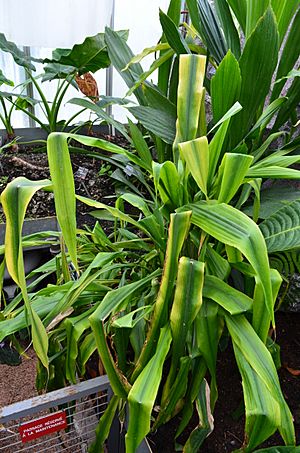Pitcairnia altensteinii facts for kids
Quick facts for kids Pitcairnia altensteinii |
|
|---|---|
 |
|
| Scientific classification | |
| Genus: |
Pitcairnia
|
| Species: |
altensteinii
|
Pitcairnia altensteinii is a special kind of plant that belongs to the Pitcairnia group. This plant is endemic to Venezuela, which means it grows naturally only in Venezuela and nowhere else in the world. It's like a unique treasure found only in that country!
Contents
About Pitcairnia Plants
The Pitcairnia genus is a large group of plants, with over 300 different species. They are part of the Bromeliaceae family, which also includes the pineapple! Most Pitcairnia plants are found in tropical and subtropical parts of the Americas, from Mexico all the way down to Argentina.
These plants often grow in rocky areas, on cliffs, or sometimes even on trees. They are known for their beautiful, often brightly colored flowers, which can be red, orange, yellow, or white. Their leaves can vary a lot too; some are long and thin, while others are wider and more sword-shaped.
Where Pitcairnia altensteinii Lives
Pitcairnia altensteinii is found only in Venezuela, a country in South America. Venezuela has many different types of environments, from tropical rainforests to mountains and grasslands. This plant prefers specific conditions, often growing in humid, warm areas.
Being endemic means that this plant has adapted perfectly to its home environment over thousands of years. It relies on the unique climate, soil, and other living things in Venezuela to survive and thrive. Protecting its natural habitat is super important to make sure this special plant continues to exist.
What Pitcairnia altensteinii Looks Like
Like other Pitcairnia species, Pitcairnia altensteinii likely has long, slender leaves that form a rosette, which is a circular arrangement of leaves close to the ground. From the center of this rosette, a tall stalk often grows, holding its flowers.
The flowers of Pitcairnia plants are usually very striking. They can be tubular or bell-shaped and are often pollinated by hummingbirds, which are attracted to their bright colors and sweet nectar. While we don't have specific details about the exact appearance of Pitcairnia altensteinii's flowers, they would certainly be a beautiful sight in its natural Venezuelan home.
Reproduction and Life Cycle
Plants like Pitcairnia altensteinii reproduce in a few ways. They can produce seeds after their flowers are pollinated. These seeds are then spread by wind, water, or animals, helping new plants grow in different places.
Many Pitcairnia plants also produce "pups" or "offsets." These are small, new plants that grow from the base of the parent plant. Once these pups are big enough, they can be separated and grow into new, independent plants. This is a common way for these plants to spread and form larger groups.
The life cycle of Pitcairnia altensteinii involves growing from a seed or pup, maturing into a full-sized plant, flowering, producing seeds and pups, and then eventually dying, making way for the next generation. This cycle ensures the species continues to thrive in its unique habitat.
Images for kids
See also
 In Spanish: Pitcairnia altensteinii para niños
In Spanish: Pitcairnia altensteinii para niños


